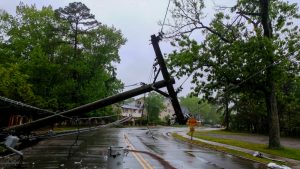The Occupational Safety and Health Administration (OSHA) urged employers, response crews, and residents in areas affected by Hurricane Ida to recognize the hazards created by fallen trees, flooding, power loss, storm debris, and structural damage in the wake of a hurricane.
Both emergency response and cleanup and recovery crews face hazards related to removing debris, repairing or replacing roofs, repairing water damage, restoring communications and electricity, and trimming trees. OSHA emphasized that only individuals with proper equipment, experience, and training should conduct recovery and cleanup activities.
Hazards that response and recovery workers may encounter can include carbon monoxide exposure from portable generators, cuts and lacerations, electrocution, falls, hazardous substances and infectious materials, heat exposure, and occupational noise. Response and recovery workers need access to protective gear, beginning with appropriate clothing and extending to American National Standards Institute (ANSI)-approved protective footwear, gloves, hard hats or helmets, and safety glasses with side shields.
Workers involved in floor or hurricane cleanup and recovery also may need respiratory protection because they may be exposed to hazardous substances, as well as protective chaps when using chain saws. In certain regions, workers may need snake boots or snake garters.
According to OSHA, those involved in response and recovery after a disaster should:
- Evaluate the work area for hazards.
- Assess the stability of structures and walking surfaces.
- Ensure fall protection is used when working on elevated surfaces.
- Assume all power lines are live.
- Keep portable generators outside, and never attach a generator directly to the electrical system of a structure unless a qualified electrician has installed a transfer switch for the generator.
- Operate chain saws, ladders, and other equipment properly.
- Use personal protective equipment (PPE), such as gloves, hard hats, hearing protection, and foot and eye safeguards.
- Wear light-colored, loose-fitting clothing; have plenty of drinking water available; use sunscreen; and take frequent rest breaks in shaded areas.
“Workers entering areas after severe weather must be prepared to do their jobs and help clean up and restore services safely,” OSHA’s Dallas Regional Administrator Eric Harbin said in an agency statement.
An OSHA fact sheet covers common safety hazards in flood cleanup. The agency’s Hurricane eMatrix outlines activities most commonly performed during hurricane response and recovery and provides detailed information about hazards associated with cleanup and recovery activities. The eMatrix offers recommendations for PPE, safe work practices, and precautions for each activity and is designed to help make decisions about recovery and cleanup worker protection.
FMCSA emergency declaration
Ahead of Hurricane Ida’s landfall, the Federal Motor Carrier Safety Administration (FMCSA) issued a regional emergency declaration for Alabama, Arkansas, Louisiana, Mississippi, Tennessee, and Texas, providing regulatory relief, including maximum driving time, for commercial motor vehicle operations directly supporting emergency relief efforts; transporting supplies, goods, equipment, and fuel into affected states; and transporting persons into and from affected states or providing other assistance in the form of emergency services during the emergency related to Hurricane Ida.
Motor carriers may not require or allow a fatigued driver to operate a commercial motor vehicle, and drug and alcohol testing requirements still apply.

